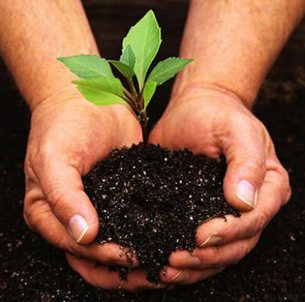How to Compost Above Ground

How to Compost Above Ground
There are any number of ways to compost your organic waste; many types of composting containers or tumblers are available, and lots of ways to build your own composting structure. However, one of the simplest ways to get your compost started is to just put it in a pile.
It might sound crazy to think that just putting your organic waste in a heap in the yard can be called composting, but remember: the composting process is completely natural, and can (and will!) occur just about anywhere.
A freestanding compost pile has its share of pros and cons. Some of the advantages of no-bin composting are:
- It's super cheap. If you're on the fence about whether composting is right for you or not, or are on a limited budget, no-bin composting is an inexpensive way to get started and learn the ins and outs of managing a compost pile without a large investment.
- It's about as easy as it gets. Collect your organic matter, put it in a pile, turn it frequently, and you're off to the races.
Collecting your organic waste into a no-bin compost pile has its' share of disadvantages to consider, including:
- Uncontained piles of decomposing organic matter may not be the most visually appealing thing to look at: for you, and especially if you've got unsupportive neighbors. Compost is a beautiful thing, but some people just don't want to see it happening before their eyes.
- It is difficult to keep pests out of a freestanding compost pile. The list of critters who may see your compost pile as a free smorgasbord include mice, raccoons, foxes, badgers, and the neighbor's dog. Keeping kitchen scraps out of a freestanding compost pile is one way to discourage pests. If you think pests will be a problem, you should consider an enclosed compost bin or underground pit or trench composting.
How to Compost - Building an Aboveground Compost Pile
It's a very easy thing to do, but where should you put your pile? Locate your no-bin compost pile somewhere where it won't get soaked with rain or blasted with sun. Somewhere shady and within easy reach of a hose is a good spot.
To start your no-bin compost pile, build a pile at least 3 x 3 x 3. This will offer enough mass for the organic matter to insulate itself and maintain adequate moisture and warmth levels for the hardworking composting critters to do their stuff.
- Chop or shred as much of the matter as you can into small pieces.
- Spread about 4 inches of woody, coarse brown material such as straw, corn stalks, or dead perennial stems to form the base of the pile.
- Sprinkle water on each new layer as you build your pile to the dampness of a wrung-out sponge. Also throw in a few handfuls of native soil between layers as well.
- Spread 4 or 5 more inches of brown matter like dry leaves or shredded newspaper.
- Spread 2 or 3 inches of green material like garden plants or grass clippings.
- Continue to layer brown and green materials, moistening as you go up. Your finished pile should have a layer of brown materials on the top.
How to Compost - Aboveground Composting: Breathe!!
All composting done aboveground works on the aerobic decomposition principle. The aerobic organisms who work their magic turning waste into compost require air to get the job done. Plenty of air is required to do the job efficiently, and that's your contribution to the success of the compost pile. Here are a few ways to keep your compost pile breathing properly:
- Consider putting your no-bin compost pile on something like an old shipping pallet to allow air to flow beneath it.
- Turn the pile completely by moving the freestanding pile to an adjacent spot with a pitchfork, or use a fork or aerator to stir the pile up in its spot. This should be done often, even daily.
- If your freestanding compost pile starts to smell, it's probably either too wet or has too much nitrogen-rich material in it like grass clippings. Mixing in more carbon-rich matter like dead leaves or straw will help soak up excess moisture and correct the nitrogen to carbon ratio.
A well-running aboveground freestanding compost pile shouldn't smell bad; it should give off a healthy, earthy aroma that is pleasant to be around.
Interested In More On Composting?
We offer a lot of information on composting and some great composting product reviews. If you really want to get your feet wet in the composting business, be sure to read these additional articles of interest:
Composting 101
Worm Composting
Vermiculture - A Worms Healthy Home
Vermicomposting - Troubleshooting Tips
Compost Pit
Compost Container
Making Compost
Soil Saver Classic Composter Product Review
GeoBin Composting Container Product Review
Worm Factory 360 Product Review



































































